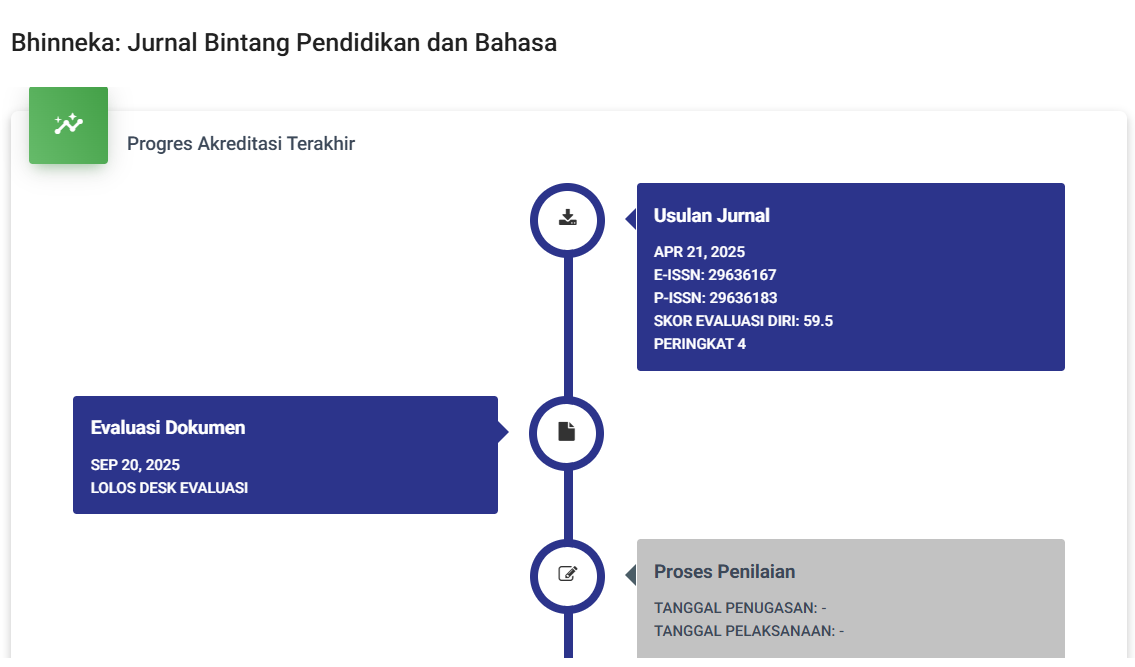Penerapan Metode Ekspository dalam Pembelajaran PAI di UPTD SD N 05 Mungka
DOI:
https://doi.org/10.59024/bhinneka.v2i4.978Keywords:
Learning Method, Expository, PAIAbstract
The author's motivation for undertaking this study stems from a previous observation that instructors continued to employ an expository method that was monotonous and devoid of variety. The instructor primarily employs the lecture method to impart the learning material, which restricts their ability to utilise infrastructure and facilities such as mind mapping and concentration for the students. This form of inquiry employs descriptive qualitative research methodology, specifically characterising a symptom associated with a current event. By utilising data collection methods such as documentation, interviews, and observation. Class V students served as the primary informants, while the Islamic Religious Education Instructor and the School Principal provided supplementary information. Following this, the author conducts data analysis through data reduction, data presentation, and conclusion drawing from the study. The findings of the study indicate that: 1) The expository method was implemented with PAI subjects. After conducting research on its learning applications, it has been optimised. Because educators possess a professional demeanour and impart knowledge in accordance with their academic credentials. 2) Possessing assets that serve as corroborating elements in the instructor's implementation and utilisation of learning resources pertaining to Islamic religious education that are accessible and deemed satisfactory in their efficacy. However, there are impediments: a) the teacher's capacity to design learning is constrained (insufficient), b) the length of the teacher's explanations is excessive, c) the reliance on textbooks lacks creativity and is monotonous, and d) educators' endeavours to surmount challenges are also hindered. when the expository method is applied to PAI subjects:. 3) Efforts made by educators to overcome inhibiting factors in the application of expository methods, especially in PAI subjects, can be overcome by developing expository methods, such as using teaching aids, and supplementing with worksheets, and using textbooks that are less imaginative, rigid, and emphasized. on factual learning, memorization, and so on. Thus, it can be stated that the application of the expository method in the implementation of the Islamic Religious Education learning process produces a good learning process and can improve student learning achievement.
References
Andy Riski Pratama, Yulius, Maysa Latifa, Syafrudin, & Messy. (2024). Inovasi kurikulum pendidikan agama Islam (PAI) dalam mendorong penanaman nilai-nilai kearifan lokal. An-Nahdlah: Jurnal Pendidikan Islam, 4(1), 145–152. https://doi.org/10.51806/an-nahdlah.v4i1.160
Danim, S. (2002). Menjadi peneliti kualitatif: Rancangan metodologi, presentasi, dan publikasi hasil penelitian untuk mahasiswa dan peneliti pemula bidang ilmu sosial, pendidikan, dan humaniora (Cet. I). Bandung: Remaja Rosdakarya.
Haedar, M. A. (2010). Pendidikan agama di Indonesia. Jakarta: Puslitbang Pendidikan Agama dan Keagamaan.
Haryanto. (2012). Pengertian pendidikan menurut para ahli. Artikel Online. Diakses dari http://belajarpsikologi.com/pengertianpendidikan-menurut-ahli/
Heriansyah. (2018). Guru adalah manajer sesungguhnya di sekolah. Jurnal Manajemen Pendidikan Islam, 1(1). https://doi.org/10.30868/im.v1i01.218
Imran, A. (1996). Belajar dan pembelajaran. Jakarta: Dunia Pustaka.
Islamuddin, H. (2012). Psikologi pendidikan. Yogyakarta: Pustaka Belajar.
Latifa, M., Pratama, A. R., Hasan, R. H., Kamal, M., & Zakir, S. (2024). Evaluation of interactive learning through the Quizizz application at MTsN 2 Payakumbuh City. J-PAI: Jurnal Pendidikan Agama Islam, 10(2).
Riski Pratama, A. (2023). The contextual teaching and learning (CTL) approach is implemented in Islamic religious education at SDN 02 Percontohan. ALIFBATA: Journal of Basic Education, 3(2), 30–38. https://doi.org/10.51700/alifbata.v3i2.515
Sarbini, & Lina, N. (2011). Perencanaan pendidikan. Bandung: Pustaka Setia.
Downloads
Published
How to Cite
Issue
Section
License
Copyright (c) 2024 Bhinneka: Jurnal Bintang Pendidikan dan Bahasa

This work is licensed under a Creative Commons Attribution-ShareAlike 4.0 International License.








